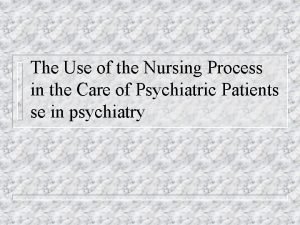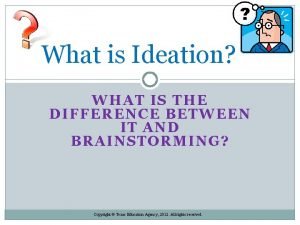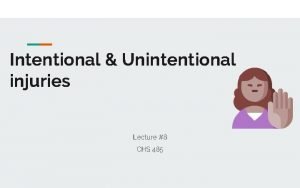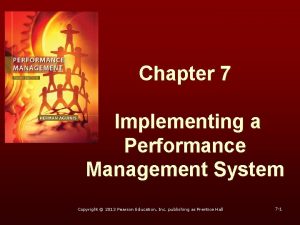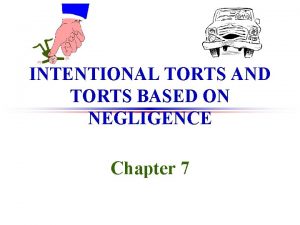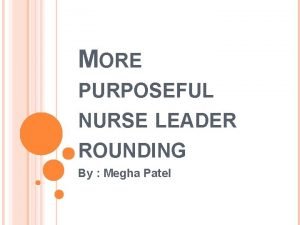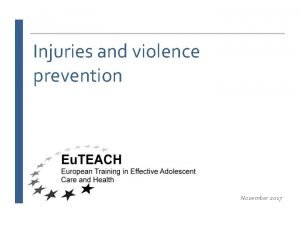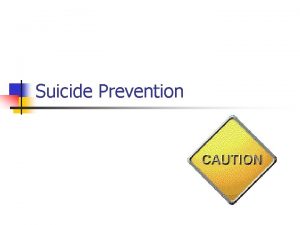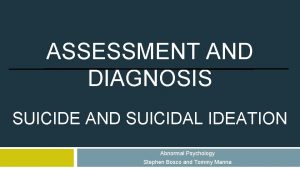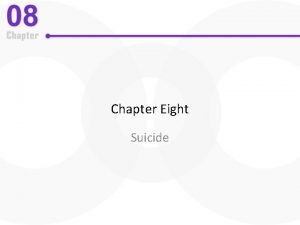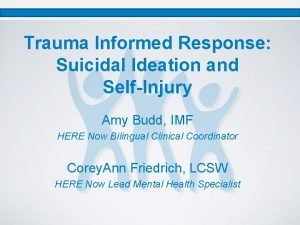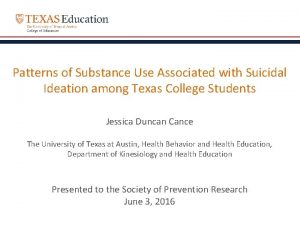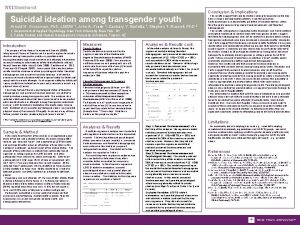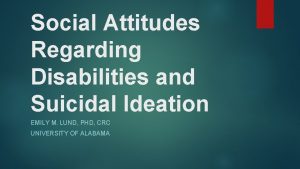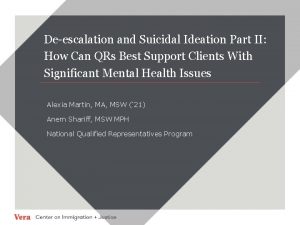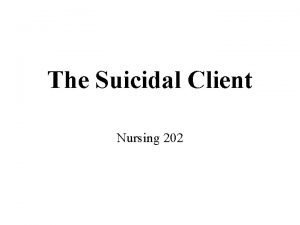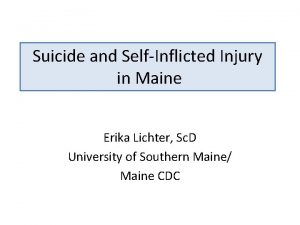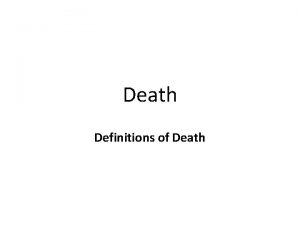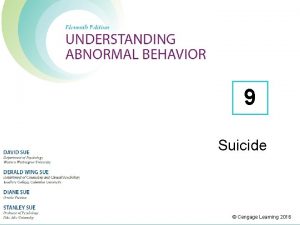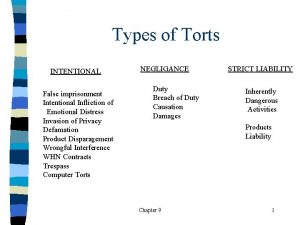Suicide Definitions Suicide intentional selfinflicted death Suicidal ideation























- Slides: 23

Suicide

Definitions Suicide: intentional self-inflicted death Suicidal ideation: thoughts of killing oneself (i. e. , serving as the agent of one’s death) Suicidal act: intentional self-injury (can have varying degrees of lethal intent)

Introduction Suicidal behaviors are the most common psychiatric emergency The 11 th leading cause of death in U. S. (2001) About 30, 000 suicides annually in U. S. Over 90% of suicide victims have a diagnosable psychiatric disorder—over half have a depressive disorder

Attempts vs. Completions Ratio of attempts to completions may be as high as 25: 1 Women more likely to attempt suicide Men more likely to complete suicide Men use more lethal means

Psychopathology is the primary underlying risk factor Major depression Bipolar disorder Schizophrenia Substance use disorders Personality disorders: borderline, antisocial Panic disorder

Highly important underlying risk factors History of previous attempts Depression Alcohol or drug abuse

Other underlying risk factors History of psychiatric hospitalization Chronic medical illness Family history of suicide History of childhood abuse (physical, verbal, or sexual) Impulsiveness

Underlying sociodemographic risk factors Social isolation: -Living alone -Not currently married (never married, separated, divorced, or widowed) Unemployment Male gender Increased age (among white men) Certain occupations: police officers, physicians

Proximal Risk Factors Intoxication Stressful life events: -loss of job -death of a loved one -divorce -migration -incarceration

Are suicides more frequent around the holidays?

Firearms greatly increase the risk of completed suicide Presence of a gun in the home increases risk of suicide 5 X Readily accessible firearms facilitate lethal impulsive acts and leave little chance for rescue 70 -90% fatality rate for suicidal firearm injuries Women’s use of firearms has risen dramatically—now firearms are leading method of completed suicide by women in U. S.

Most common methods of completed suicide Men Women 1. Firearms (61%) 1. Firearms (37%) 2. Hanging 2. Self-poisoning

Psychological factors/theories Hopelessness, despair, desperation Freud: aggression turned inward Escape from rage Guilt; self-punishment or atonement Rebirth or reunion fantasies Control over a relationship Revenge

Religion and Suicide Lower rates among Jews and Catholics, presumably due to religious prohibition Lower rates in predominately Catholic countries, but this is not consistent Religious affiliation is apparently less important than religious involvement and participation in affecting risk of suicide

Suicide and Schizophrenia (I) 33 -50% with schizophrenia will attempt suicide Approximately 10% with schizophrenia die by suicide Gender: equal attempt ratio, more men die by suicide Isolation (single, living alone, unemployed) Substance abuse Akathisia

Suicide and Schizophrenia (II) Periods of increased risk: Highest risk in first 10 years of illness When depression When hopeless After resolution of an acute psychotic exacerbation Days, weeks, months after hospitalization Persons with more “insight” thought to be at higher risk of suicide

Suicide among physicians Rate higher than general population, particularly for women doctors (same rate in male, female MDs) Unrecognized and untreated depression a common theme Physician help-seeking highly suboptimal: 1/3 of physicians have no regular doctor Low rates of seeking help for depression Professional attitudes discourage admission of health vulnerabilities Concerns about confidentiality, licensing, privileges, medical insurance, malpractice insurance When seek help often quite ill

Assessment of suicidality Ask about suicidality in every initial psychiatric assessment Asking about suicidality does not suggest it Do not dismiss someone’s suicidal comments Spectrum of suicidality: passive thoughts, plan, intent, attempt Intent is not always communicated No absolute predictive test or criteria

When assessing suicide risk, consider: Pervasiveness of thoughts Plan Lethality of plan/attempt Availability of lethal means Likelihood of rescue

Markers of increased suicide risk Preparations for death: Settling affairs, giving away personal items, writing a note Sudden change of mood Lack of future plans Recent loss Symptoms: Insomnia, hopelessness, severe anxiety, extreme restlessness or agitation

Management of suicidal patients Determine treatment setting: Inpatient or outpatient Caution regarding “contracts for safety” Medications Limit availability of firearms, lethal drugs, other means Access to crisis services needed Therapy

Regarding risk factors for suicide Risk factors alone or in combination do not allow accurate prediction of a specific individual’s suicide However, knowledgeable assessment of risk and protective factors can allow estimation of an individual’s risk and can be used to formulate a plan to reduce the risk of suicide

What every doctor and nurse should know about suicide Depression is the most common diagnosis associated with suicide: recognize it, treat or refer Do not ignore suicidal comments, threats Asking about suicide does not suggest it The 3 most important risk factors: history of suicide attempts, depression, substance abuse
 Bab 20
Bab 20 Nursing care plan for homicidal ideation
Nursing care plan for homicidal ideation New buzz word for brainstorming
New buzz word for brainstorming Brilhart-jochem ideation criteria
Brilhart-jochem ideation criteria Ideation international
Ideation international Difference between somatic death and molecular death
Difference between somatic death and molecular death Jennifer joan thompson
Jennifer joan thompson Food adulteration define
Food adulteration define Law of torts
Law of torts What is intentional and unintentional injury
What is intentional and unintentional injury Be intentional in relationships
Be intentional in relationships Intentional christian living
Intentional christian living Therapeutic touch
Therapeutic touch By and large what is the cause of intentional rating errors
By and large what is the cause of intentional rating errors Intentional slut behaviour
Intentional slut behaviour Immoral management model
Immoral management model Example of intentional injury
Example of intentional injury Definition of intentional fallacy
Definition of intentional fallacy Nurse leader rounding tools
Nurse leader rounding tools Conventional approach in ethics
Conventional approach in ethics Intentional tort examples
Intentional tort examples Intentional misstatement
Intentional misstatement Creative curriculum intentional teaching cards
Creative curriculum intentional teaching cards Example of intentional injury
Example of intentional injury

